Class 16: Dynamics on Networks 1 — Diffusion and Random Walks#
Goal of today’s class:
Introduce dynamics on networks
Define random walk dynamics
Explore core results in random walks on networks
Acknowledgement: Some of the material in this lesson is based on a previous course offered by Matteo Chinazzi and Qian Zhang.
Come in. Sit down. Open Teams.
Make sure your notebook from last class is saved.
Open up the Jupyter Lab server.
Open up the Jupyter Lab terminal.
Activate Conda:
module load anaconda3/2022.05Activate the shared virtual environment:
source activate /courses/PHYS7332.202510/shared/phys7332-env/Run
python3 git_fixer2.pyGithub:
git status (figure out what files have changed)
git add … (add the file that you changed, aka the
_MODIFIEDone(s))git commit -m “your changes”
git push origin main
import networkx as nx
import numpy as np
import matplotlib.pyplot as plt
from matplotlib import rc
rc('axes', axisbelow=True)
rc('axes', fc='w')
rc('figure', fc='w')
rc('savefig', fc='w')
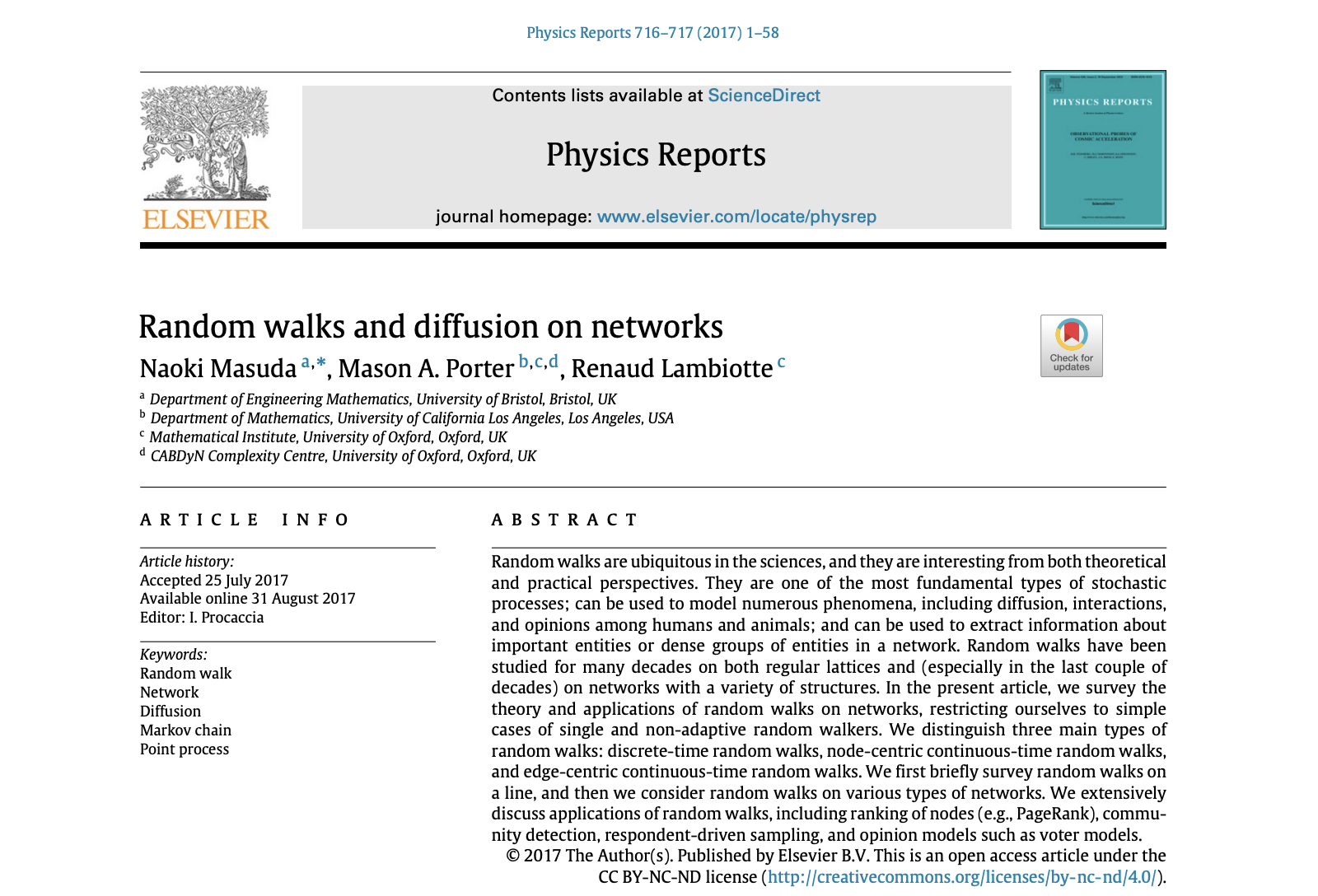
Random walks in 1-dimension (not networks yet!)#
The concept of a random walk shows up all over the place in mathematics and across various scientific disciplines; the key insight is to use this notion as a tool to study processes where a system evolves based on a series of random, discrete steps. In this section, we begin with a formal definition of the 1-D random walker and examine key metrics such as expected displacement, variance, and probability distributions that characterize the walk’s dynamics over time.
Some good references:
Lawler, G.F. & Limic, V. (2010). Random walk: a modern introduction (Vol. 123). Cambridge University Press. https://www.cambridge.org/core/books/random-walk-a-modern-introduction/7DA2A372B5FE450BB47C5DBD43D460D2
Lovász, L. (1993). Random walks on graphs. Combinatorics, Paul Erdos is Eighty, 2(1-46), 4. https://www.cse.cuhk.edu.hk/~cslui/CMSC5734/LovaszRadnomWalks93.pdf
Consider a walker starting at an origin point \(y=0\) on a 1-D integer lattice, where each position on the lattice corresponds to an integer. At each discrete time step, \(t\), the walker either moves one step to up (\(y_{t+1} = y_{t}+1\)) or one step down (\(y_{t+1} = y_{t}-1\)), with equal probability, \(P(\textrm{move up}) = P(\textrm{move down}) = \frac{1}{2}\). (Note this can also be thought of as a 1-D line that the walker moves left or right on, but for visualization purposes, let’s use up/down.) This unbiased process is governed by a Bernoulli distribution, where each step is independent of the previous ones.
Let \(Y_t\) denote the position of the random walker at time \(t\). \(Y_t\) can then be written as the sum of \(t\) i.i.d. random variables \(\eta_i\), where \(\eta_i\) corresponds the outcome at each step (i.e., \(\eta_i = \pm 1\)), \(Y_t = \sum_{i=1}^t \eta_i\). The expectation of \(\eta_i\) is 0, and its variance is 1. Therefore, the expected position of a given random walker at time \(t\) can be written \(E[Y_t] = t E[\eta_i] = 0\), and the variance of the walker’s position grows with \(t\) as \(\textrm{Var}(Y_t) = t \textrm{Var}(\eta_i) = t\).
As \(t \rightarrow \infty\), we see that the position of the random walker can be estimated by a normal distribution \(Y_t \sim \mathcal{N} (0, t)\) (see: the Central Limit Theorem), and as a result, the probability density over the walker’s position at large enough \(t\) is:
This behavior forms one of the key insights for building random walkers beyond one dimensions! In Physics, we often see it used for studying diffusion processes. In Economics or Finance, we can use it as a foundation for building models of the stock market. In Biology, we can think of it as the base for models of particle motion in a cell. And in Network Science, random walks can be used as the starting point for algorithms that characterize network connectivity or centrality, community structure, spectral properties, and more.
5-min challenge! Code a single random walker#
Let’s start the class off with a challenge. As defined above, code a single random walker, moving up and down with equal probability (\(p=0.5\)). Visualize this walker’s trajectory over 10,000 timesteps.
We’ve given you a starter-function single_1d_walkers below.
If you have time, adapt this to a general function that returns the trajectory for n_iter random walkers.
def single_1d_walkers(t=10000, start_position=0, p_up=0.5):
"""
Simulates the path of a single random walker on a 1-dimensional lattice.
Parameters
----------
t : int, optional
The number of steps the random walker will take.
start_position : int, optional
The starting position of the walker on the lattice. Default is 0.
p_up : float, optional
The probability that the walker takes an `up` step. 0.5 indicates
an unbiased random walker.
Returns
-------
positions_over_time: vector of ints
A list-like object representing the positions of the walker at each
step, starting from the initial position.
Notes
-----
- At each step, the walker moves either +1 (up) or -1 (down) with equal
probability.
- This random walk is unbiased, with each step being independent of the
previous one.
Examples
--------
>>> random_walk_1d(5, start_position=0)
[0, 1, 0, 1, 2, 1]
"""
positions_over_time = np.zeros(t)
pass
return positions_over_time
Plot your walker below
fig, ax = plt.subplots(1,1,figsize=(7,5),dpi=100)
t = 10000
positions = single_1d_walkers(t)
ax.plot(range(t),positions, lw=0.5, color='.2', label='walker trajectory')
ax.scatter(0,0,color='red',zorder=3,label='starting location')
ax.legend(loc=2)
ax.set_ylabel('Location of walker')
ax.set_xlabel('Time')
ax.grid(alpha=0.2, color='.6', lw=1)
ax.set_title('Single random walker (1-Dimension)')
ylims = ax.get_ylim()
ax.set_ylim(-np.abs(ylims).max(), np.abs(ylims).max())
ax.set_xlim(-1, t+1)
plt.show()
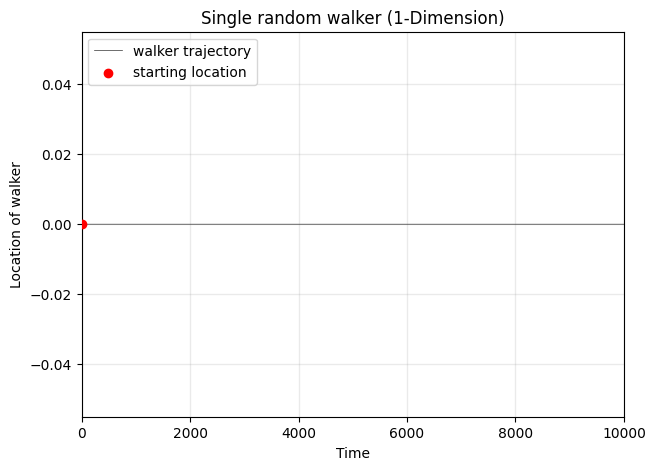
fig, ax = plt.subplots(1,1,figsize=(7,5),dpi=100)
up_prob = 0.5
probs = [up_prob, 1-up_prob]
timesteps = 10000
n_runs = 20
positions = np.zeros(timesteps)
for t in range(1, timesteps):
positions[t] = positions[t-1]
positions[t] += np.random.choice([1,-1], p=probs)
ax.plot(range(timesteps),positions, lw=0.5, color='.2', label='walker trajectory')
ax.scatter(0,0,color='red',zorder=3,label='starting location')
ax.legend(loc=2)
ax.set_ylabel('Location of walker')
ax.set_xlabel('Time')
ax.grid(alpha=0.2, color='.6', lw=1)
ax.set_title('Single random walker (1-Dimension)')
ylims = ax.get_ylim()
ax.set_ylim(-np.abs(ylims).max(), np.abs(ylims).max())
ax.set_xlim(-1, timesteps+1)
plt.show()
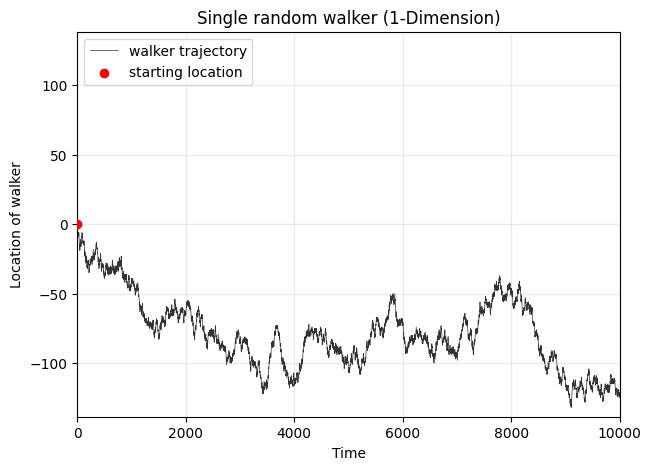
Note on the implementation above: is there a faster way to do this?#
def single_1d_walkers(t=10000, start_position=0, p_up=0.5):
"""
Simulates the path of a single random walker on a 1-dimensional lattice.
Parameters
----------
t : int, optional
The number of steps the random walker will take.
start_position : int, optional
The starting position of the walker on the lattice. Default is 0.
p_up : float, optional
The probability that the walker takes an `up` step. 0.5 indicates
an unbiased random walker.
Returns
-------
positions_over_time: vector of ints
A list-like object representing the positions of the walker at each
step, starting from the initial position.
Notes
-----
- At each step, the walker moves either +1 (up) or -1 (down) with equal
probability.
- This random walk is unbiased, with each step being independent of the
previous one.
Examples
--------
>>> random_walk_1d(5, start_position=0)
[0, 1, 0, 1, 2, 1]
"""
# Generate random steps (-1, 0, or 1) for both up and down directions
directions = np.random.choice([-1, 1],
size=(t, 1),
p=[1-p_up, p_up])
# Compute the cumulative sum to get the position at each step
positions_over_time = np.cumsum(directions, axis=0)
return positions_over_time
def random_walk_1d(n_walkers=1, t=10000, start_position=0, p_up=0.5):
"""
Simulates the path of a single random walker on a 1-dimensional lattice.
Parameters
----------
n_walkers : int, optional
t : int, optional
The number of steps the random walker will take.
start_position : int, optional
The starting position of the walker on the lattice. Default is 0.
p_up : float, optional
The probability that the walker takes an `up` step. 0.5 indicates
an unbiased random walker.
Returns
-------
positions_over_time: vector of ints
A list-like object representing the positions of the walker at each
step, starting from the initial position.
Notes
-----
- At each step, the walker moves either +1 (up) or -1 (down) with equal
probability.
- This random walk is unbiased, with each step being independent of the
previous one.
Examples
--------
>>> random_walk_1d(5, start_position=0)
[0, 1, 0, 1, 2, 1]
"""
all_walkers = []
for _ in range(n_walkers):
# Generate random steps (-1, 0, or 1) for both up and down directions
directions = np.random.choice([-1, 1],
size=(t, 1),
p=[1-p_up, p_up])
# Compute the cumulative sum to get the position at each step
positions_over_time = np.cumsum(directions, axis=0)
all_walkers.append(positions_over_time.T[0])
if n_walkers == 1:
return positions_over_time
else:
return np.array(all_walkers)
fig, ax = plt.subplots(1,1,figsize=(7,5),dpi=100)
timesteps = 10000
n_iter = 1000
up_prob = 0.5
walkers = random_walk_1d(n_walkers=n_iter, t=timesteps, start_position=0, p_up=up_prob)
averages = []
maxes = []
for walker in walkers:
ax.plot(walker, lw=0.25, alpha=0.5)
averages.append(list(walker))
maxes.append(max(walker))
ax.plot(np.array(averages).mean(axis=0),color='.2',lw=4,alpha=0.8,ls='--',
label='average across walkers')
ax.legend(loc=2)
ax.set_ylabel('Location of walker')
ax.set_xlabel('Time')
ax.grid(alpha=0.2, color='.6', lw=1)
ax.set_title('Many random walkers (1-dimension)')
ylims = ax.get_ylim()
ax.set_ylim(-np.abs(ylims).max(), np.abs(ylims).max())
ax.set_xlim(-1, timesteps+1)
plt.show()
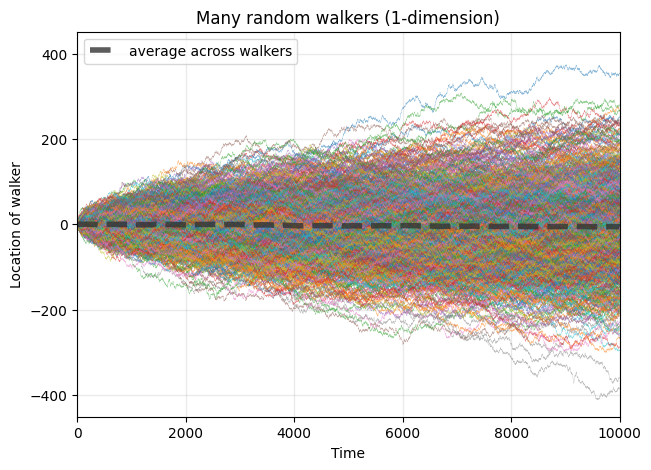
Question: How does the standard deviation of walkers’ locations change over time?#
standard_devs = np.array(averages).std(axis=0)
fig, ax = plt.subplots(1,1,figsize=(7,5),dpi=100)
ax.loglog(standard_devs, color='.2', lw=2, alpha=0.8, label='computed standard deviations')
ax.loglog(np.sqrt(list(range(1,timesteps))),lw=2,color='orange',ls='--', label=r'$\sqrt{N}$')
ax.legend(loc=2)
ax.set_ylabel('Standard deviation of walker location')
ax.set_xlabel('Time')
ax.grid(alpha=0.2, color='.6', lw=1)
ax.set_title("Std. dev. of many random walkers's positions (1-dimension)")
plt.show()
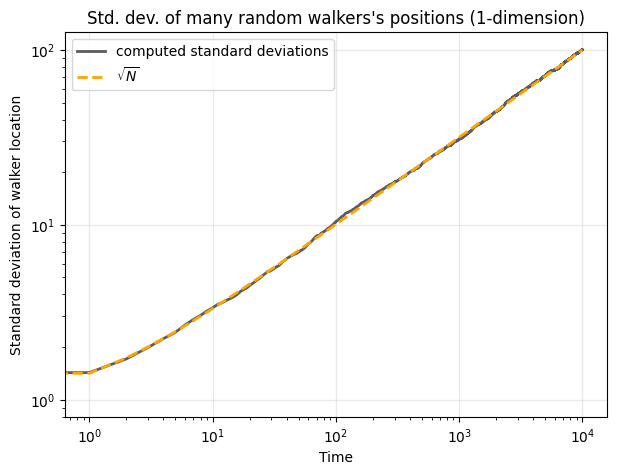
Question: What is the distribution of the maximum value of each walker’s trajectory?#
fig, ax = plt.subplots(1,1,figsize=(7,5),dpi=100)
ax.hist(maxes, bins=30, density=True, ec='w', color='.2')
ax.set_ylabel('Density')
ax.set_xlabel('Maximum walker position')
ax.grid(alpha=0.2, color='.6', lw=1)
ax.set_title("Distribution of walkers' maximum positions")
ax.set_xlim(-1, max(maxes)+1)
plt.show()
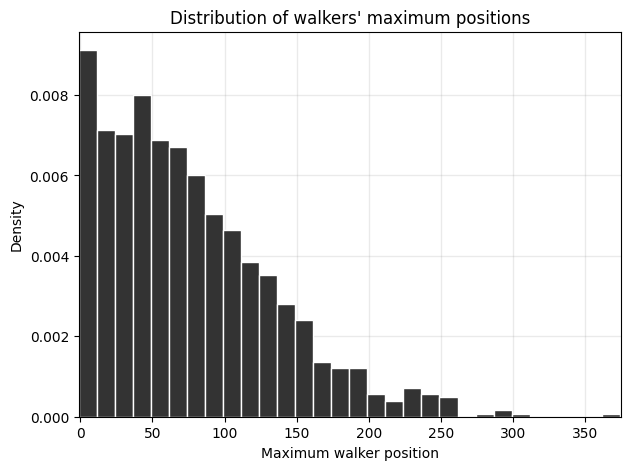
The distribution of the maximum of a one-dimensional random walk is a classical extreme value distribution called the Fréchet distribution.
# from scipy.stats import genextreme
# # Step 1: Simulate multiple walks
# n_steps = 10000 # Number of steps in each random walk
# n_walks = 100000 # Number of random walks to simulate
# maxima = random_walk_1d(n_walks, n_steps)
# # Step 2: Fit the maxima to a Fréchet (generalized extreme value) distribution
# c, loc, scale = genextreme.fit(maxima)
# # Step 3: Plot the results
# x = np.linspace(min(maxima), max(maxima), 100)
# pdf_frechet = genextreme.pdf(x, c, loc=loc, scale=scale)
# plt.hist(maxima, bins=50, density=True, alpha=0.6, color='blue', label="Simulated Maxima")
# plt.plot(x, pdf_frechet, 'r-', label="Fitted Fréchet PDF")
# plt.xlabel("Maxima of Random Walk")
# plt.ylabel("Density")
# plt.legend()
# plt.title(f"Fitting Fréchet Distribution to Maxima of {n_walks} Random Walks")
# plt.show()
Random walks in 2-dimensions (still not networks yet!)#
In the two-dimensional random walk, we imagine a walker starting at an origin point \((x,y) = (0,0)\) on a 2-D integer lattice, where each point corresponds to a coordinate. At each timestep, \(t\), a walker moves randomly up / down / left / right with equal probability \(P(\textrm{up}) = P(\textrm{down}) = P(\textrm{left}) = P(\textrm{right}) = \frac{1}{4}\).
There are similarities here to the 1-D walkers, such that the expected position of the walker will be
$\(X_t = \sum_{i=1}^{t} \eta_{x,i}, \quad Y_t = \sum_{i=1}^{t} \eta_{y,i}\)$,
where \( \eta_{x,i} \) and \( \eta_{y,i} \) are random variables representing the steps in the \( x \) and \( y \) directions, respectively. Each of these steps is uniformly distributed over {-1, 1}.
Similar to the one-dimensional case, the expected position of the walker remains at the origin: \(E[X_t] = E[Y_t] = 0\). The variance of each coordinate grows linearly with time, as in the one-dimensional case. However, the combined radial distance from the origin \( R_t = \sqrt{X_t^2 + Y_t^2} \) is an important quantity that provides a measure of the walker’s spread in two dimensions. The expected value of \( R_t \) grows as \(E[R_t] \approx \sqrt{t}\) indicating diffusive behavior in two dimensions, with the walker’s distance from the origin increasing proportionally to the square root of time.
2-D random walks are also used to study many processes, from the movement of particles in a fluid (Brownian motion) to animal foraging behavior. This section introduces the two-dimensional random walk as a stepping stone to more complex random walks on networks, where the underlying structure influences the walker’s movement in ways that go beyond free-space diffusion.
rc('axes', fc='w')
rc('figure', fc='w')
rc('savefig', fc='w')
fig, ax = plt.subplots(1,1,figsize=(5,5),dpi=150,sharex=True,sharey=True)
plt.subplots_adjust(wspace=0.05)
# Set random seed for reproducibility
# np.random.seed(10)
# Parameters
num_steps = 100000 # Number of steps in the random walk
# Initialize starting position (at origin)
x = np.zeros(num_steps)
y = np.zeros(num_steps)
# Perform the random walk
for i in range(1, num_steps):
direction = np.random.choice(['up', 'down', 'left', 'right']) # Choose a direction randomly
if direction == 'up':
y[i] = y[i - 1] + 1
x[i] = x[i - 1]
elif direction == 'down':
y[i] = y[i - 1] - 1
x[i] = x[i - 1]
elif direction == 'left':
x[i] = x[i - 1] - 1
y[i] = y[i - 1]
else: # 'right'
x[i] = x[i - 1] + 1
y[i] = y[i - 1]
# Plot the random walk path
ax.scatter(x, y, c=np.linspace(0.1,1,len(x)), marker='.', s=1, lw=0, cmap='viridis', vmin=0, vmax=1)
ax.scatter(0, 0, color='red')
ax.tick_params(axis='both',labelbottom=False,labelleft=False)
ax.grid(alpha=0.2, color='.6', lw=1)
xlims = ax.get_xlim()
ylims = ax.get_ylim()
max_lim = max(max(np.abs(xlims)),max(np.abs(ylims)))
ax.set_ylim(-max_lim,max_lim)
ax.set_xlim(-max_lim,max_lim)
ax.set_title('Single random walker (2-dimensions)')
plt.show()

def random_walk_2d(n_walkers=1, t=10000, start_position=(0, 0), p_move=0.25):
"""
Simulates the path of one or more random walkers on a 2-dimensional lattice.
Parameters
----------
n_walkers : int, optional
The number of random walkers to simulate. Default is 1.
t : int, optional
The number of steps each random walker will take. Default is 10000.
start_position : tuple of ints, optional
The starting (x, y) position of each walker on the lattice. Default is (0, 0).
p_move : float, optional
The probability for each direction (up, down, left, right). Default is 0.25,
indicating an unbiased random walker.
Returns
-------
positions_over_time : numpy.ndarray
An array representing the positions of each walker at each step. Shape is
(n_walkers, t, 2), where each entry is the (x, y) position at each time step.
Notes
-----
- Each step moves the walker either up, down, left, or right with equal probability.
- This random walk is unbiased, with each step being independent of previous steps.
Examples
--------
>>> random_walk_2d(n_walkers=1, t=5, start_position=(0, 0))
array([[[0, 0],
[0, 1],
[1, 1],
[1, 0],
[2, 0]]])
"""
all_walkers = []
for _ in range(n_walkers):
step_choices = np.random.choice([0, 1, 2, 3], size=t)
moves = np.array([[0,1], # up
[0,-1], # down
[1,0], # right
[-1,0]] # left
)[step_choices]
positions_over_time = np.cumsum(moves, axis=0) + np.array(start_position)
all_walkers.append(positions_over_time)
return np.array(all_walkers) if n_walkers > 1 else positions_over_time
t = 10000
start_position = (0,0,0)
step_choices = np.random.choice([0, 1, 2, 3, 4, 5], size=t)
moves = np.array([[0,0,1], # up
[0,0,-1], # down
[1,0,0], # right
[-1,0,0], # left
[0,1,0], # forward
[0,-1,0]] # backward
)[step_choices]
positions_over_time = np.cumsum(moves, axis=0) + np.array(start_position)
fig, ax = plt.subplots(1,4,figsize=(20,5),dpi=200,sharex=True,sharey=True)
plt.subplots_adjust(wspace=0.05)
max_lims = []
cmaps = ['Greens','Blues','Reds','Purples']
# Set random seed for reproducibility
np.random.seed(5)
# Parameters
num_steps = 100000 # Number of steps in the random walk
for zz in range(len(cmaps)):
walk = random_walk_2d(1, num_steps)
x = walk[:,0]
y = walk[:,1]
# Plot the random walk path
ax[zz].scatter(x, y, c=np.linspace(0.1,1,len(x)), marker='o',
s=1, lw=0, cmap=cmaps[zz], vmin=0, vmax=1)
ax[zz].scatter(0, 0, color='red')
ax[zz].tick_params(axis='both',labelbottom=False,labelleft=False)
ax[zz].grid(alpha=0.2, color='.6', lw=1)
xlims = ax[zz].get_xlim()
ylims = ax[zz].get_ylim()
max_lim = max(max(np.abs(xlims)),max(np.abs(ylims)))
max_lims.append(max_lim)
max_lim = max(max_lims)
for a in fig.axes:
a.set_ylim(-max_lim,max_lim)
a.set_xlim(-max_lim,max_lim)
plt.suptitle('Four examples of random walker trajectories in 2-dimensions',fontsize='xx-large')
plt.show()

mean_centers = []
num_steps = 10000
runs = random_walk_2d(n_walkers=100, t=num_steps)
for i in range(runs.shape[0]):
x = runs[i][:,0]
y = runs[i][:,1]
mc_i = [(np.mean(y[:zz])**2 + \
np.mean(x[:zz])**2)**0.5 for zz in range(len(x))]
mean_centers.append(mc_i)
/opt/hostedtoolcache/Python/3.11.13/x64/lib/python3.11/site-packages/numpy/core/fromnumeric.py:3464: RuntimeWarning: Mean of empty slice.
return _methods._mean(a, axis=axis, dtype=dtype,
/opt/hostedtoolcache/Python/3.11.13/x64/lib/python3.11/site-packages/numpy/core/_methods.py:192: RuntimeWarning: invalid value encountered in scalar divide
ret = ret.dtype.type(ret / rcount)
# standard_devs = np.array(averages).std(axis=0)
fig, ax = plt.subplots(1,1,figsize=(7,5),dpi=100)
ax.loglog(np.mean(mean_centers,axis=0), color='.2', lw=2, alpha=0.8, label='computed centers of mass')
ax.loglog(np.sqrt(list(range(1,num_steps)))/2,lw=2,color='orange',ls='--', label=r'$\sqrt{N}/2$')
ax.legend(loc=2)
ax.set_ylabel('Average distance from the origin')
ax.set_xlabel('Time')
ax.grid(alpha=0.2, color='.6', lw=1)
ax.set_title("Mean distance from starting location (2-dimensions)")
plt.show()
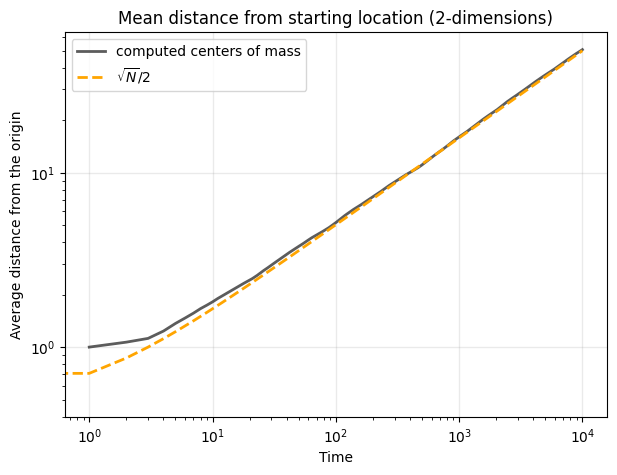
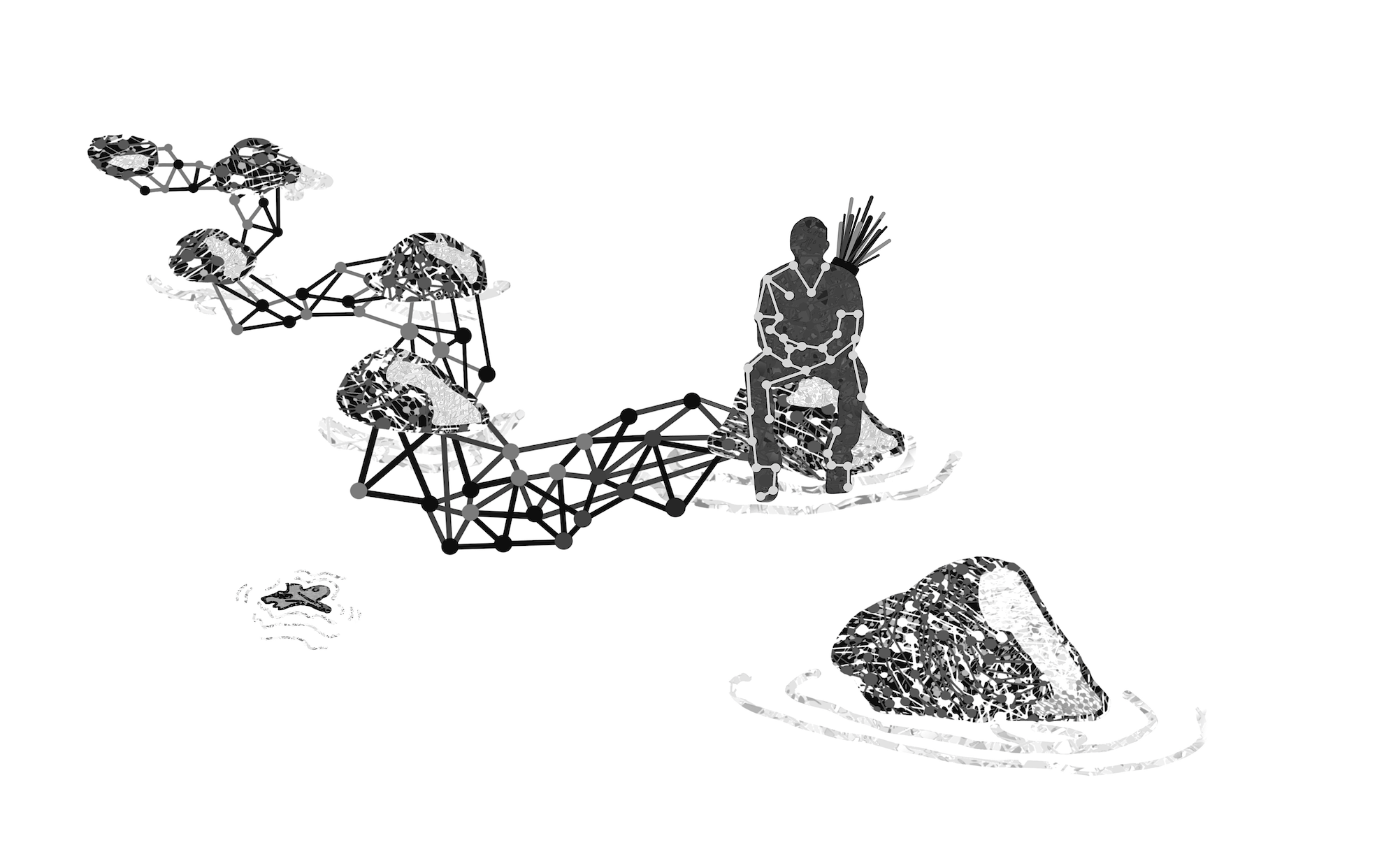
Random walks on networks#
Having explored random walks in one and two dimensions, we now extend the concept to networks! What dimension do we usually consider networks to have?
Key Concepts and Definitions#
In a network, each node has its own transition probabilities to its neighboring nodes, often determined by its degree, meaning the probability of a walker transitioning from one node to another varies according to the structure of the network. For an undirected network, we define a basic random walk as follows:
Starting Point: The walker begins at an “origin” node.
Transition Rules: At each time step, the walker moves to a neighboring node, (usually) chosen uniformly from all neighbors of the current node. This is an unbiased random walk on an undirected network.
Transition Probability: The probability of moving from node \(i\) to an adjacent node \(j\) is inversely proportional to the degree of \(i\) (i.e., \( p_{ij} = \frac{1}{k_i} \)).
Common properties to calculate with random walks#
Hitting Time: The expected time for a walker to reach a specific target node for the first time.
Return Probability: The probability that the walker will return to the origin node after a given time \(t\).
Stationary Distribution: For large \( t \), the walker’s position converges to a stationary distribution, where the probability of finding the walker at each node is stable. For an undirected network, the stationary probability \( \pi_i \) at node ( i ) is proportional to its degree, \( \pi_i = \frac{k_i}{2 E} \), where \(E\) is the number of edges.
Mixing Time: The time required for the distribution of the walker’s position to approximate the stationary distribution closely.
Applications and Relevance#
Random walks on networks serve as models for a wide range of processes, including:
Network Navigation and Search: Models how information or resources are spread or located within a network.
PageRank: Google’s PageRank algorithm uses a variant of a random walk to rank websites by their importance based on link structure.
Diffusion in Social Networks: Models information spread, where each “walker” represents the spread of ideas, memes, or infections.
This section will introduce random walks on networks through hands-on examples, providing an intuitive understanding of how different network structures influence the dynamics of the walk.
…but first… code it yourself!#
def random_walk_network(G, start_node, steps):
"""
Simulates a random walk on a network, represented as a graph.
Starting from the specified node, the walker moves to a randomly selected
neighboring node at each step. If the walker reaches an isolated node (one with
no neighbors), the walk terminates early.
Parameters
----------
G : networkx.Graph
The graph representing the network on which the random walk is performed.
Nodes should be connected by edges, as each edge represents a possible transition.
start_node : node
The node in G where the random walk starts. Must be a valid node in the graph.
steps : int
The number of steps the random walker will attempt to take. Note that the walk
may terminate early if an isolated node is reached.
Returns
-------
path : list
A list of nodes representing the path taken by the walker, starting from
`start_node`. The list length will be `steps + 1` unless the walk terminates early
at an isolated node.
Notes
-----
- At each step, the walker chooses a neighboring node uniformly at random.
- If the walker reaches an isolated node (one with no neighbors), the walk stops early.
- This function assumes the graph `G` is undirected, but it can be adapted for
directed networks by modifying the neighbor selection.
Examples
--------
>>> G = nx.path_graph(5) # Simple path graph with 5 nodes
>>> random_walk_network(G, start_node=0, steps=10)
[0, 1, 2, 1, 2, 3, 2, 1, 0, 1, 2]
"""
# Initialize the path list with the starting node
pass
return path # Return the full path taken by the walker
G = nx.karate_club_graph()
(don’t look below please)
def random_walk_network(G, start_node, steps):
"""
Simulates a random walk on a network, represented as a graph.
Starting from the specified node, the walker moves to a randomly selected
neighboring node at each step. If the walker reaches an isolated node (one with
no neighbors), the walk terminates early.
Parameters
----------
G : networkx.Graph
The graph representing the network on which the random walk is performed.
Nodes should be connected by edges, as each edge represents a possible transition.
start_node : node
The node in G where the random walk starts. Must be a valid node in the graph.
steps : int
The number of steps the random walker will attempt to take. Note that the walk
may terminate early if an isolated node is reached.
Returns
-------
path : list
A list of nodes representing the path taken by the walker, starting from
`start_node`. The list length will be `steps + 1` unless the walk terminates early
at an isolated node.
Notes
-----
- At each step, the walker chooses a neighboring node uniformly at random.
- If the walker reaches an isolated node (one with no neighbors), the walk stops early.
- This function assumes the graph `G` is undirected, but it can be adapted for
directed networks by modifying the neighbor selection.
Examples
--------
>>> G = nx.path_graph(5) # Simple path graph with 5 nodes
>>> random_walk_network(G, start_node=0, steps=10)
[0, 1, 2, 1, 2, 3, 2, 1, 0, 1, 2]
"""
# Initialize the path list with the starting node
path = [start_node]
# Set the current node to the starting node
current_node = start_node
# Iterate for the specified number of steps
for _ in range(steps):
# Get the list of neighbors of the current node
neighbors = list(G.neighbors(current_node))
# If the current node has neighbors, move to a randomly chosen neighbor
if neighbors:
next_node = np.random.choice(neighbors) # Select a random neighbor
path.append(next_node) # Append the selected neighbor to the path
current_node = next_node # Update the current node
else:
# If no neighbors (isolated node), terminate the walk early
break
return path # Return the full path taken by the walker
np.random.seed(2)
G = nx.karate_club_graph()
pos = nx.spring_layout(G) # Layout for node positions
pos[33] = np.array([0.28, 0.16])
pos[13] = np.array([-0.09983414, 0.01])
from collections import Counter
len_path = 1000
edge_cols = plt.cm.hsv(np.linspace(0,1,G.number_of_edges()))
np.random.seed(1)
np.random.shuffle(edge_cols)
edge_colors2 = {(i[0],i[1]):edge_cols[ix] for ix, i in enumerate(G.edges())}
edge_colors = {(i[1],i[0]):edge_cols[ix] for ix, i in enumerate(G.edges())}
edge_colors.update(edge_colors2)
path = random_walk_network(G, 0, len_path)
node_visits = {i:dict(Counter(path))[i] for i in G.nodes()}
node_sizes = {i:750*j/max(node_visits.values()) for i,j in node_visits.items()}
xvals_path = list(list(zip(*[pos[i] for i in path]))[0])
yvals_path = list(list(zip(*[pos[i] for i in path]))[1])
xvals = list(list(zip(*[pos[i] for i in G.nodes()]))[0])
yvals = list(list(zip(*[pos[i] for i in G.nodes()]))[1])
fig, ax = plt.subplots(1,1,figsize=(7,5),dpi=150)
cols = plt.cm.viridis(np.linspace(0,1,len_path))
path_wiggle_n = 20
path_wiggle_var = 0.01
for i in range(len_path-1):
start_xi = xvals_path[i]
end_xi = xvals_path[i+1]
col_i = edge_colors[(path[i],path[i+1])]
ogx = np.linspace(start_xi, end_xi, path_wiggle_n)
og2x = ogx.copy()
og2x_first = list(np.linspace(ogx[0], ogx[int(path_wiggle_n/2)] + np.random.normal(0,path_wiggle_var*3),
int(path_wiggle_n/2)))
og2x_second = list(np.linspace(og2x_first[-1], ogx[-1], int(path_wiggle_n/2)))
path_plot_xi = np.array(og2x_first+og2x_second) + np.random.normal(0, path_wiggle_var, path_wiggle_n)
start_yi = yvals_path[i]
end_yi = yvals_path[i+1]
ogy = np.linspace(start_yi, end_yi, path_wiggle_n)
og2y = ogy.copy()
og2y_first = list(np.linspace(ogy[0], ogy[int(path_wiggle_n/2)] + np.random.normal(0,path_wiggle_var*3),
int(path_wiggle_n/2)))
og2y_second = list(np.linspace(og2y_first[-1], ogy[-1], int(path_wiggle_n/2)))
path_plot_yi = np.array(og2y_first+og2y_second) + np.random.normal(0, path_wiggle_var, path_wiggle_n)
ax.plot(path_plot_xi, path_plot_yi, alpha=0.2, color=col_i, lw=0.4)
nx.draw_networkx_nodes(G, pos, node_color='k', node_size=list(node_sizes.values()), ax=ax, edgecolors='w')
nx.draw_networkx_edges(G, pos, edge_color='.5', width=2, ax=ax, alpha=0.2)
nx.draw_networkx_labels(G, pos, font_color='w', ax=ax, font_size='xx-small')
# ax.scatter(xvals,yvals, c='k',s=list(node_sizes.values()),zorder=20,ec='w')
ax.set_axis_off()
plt.show()
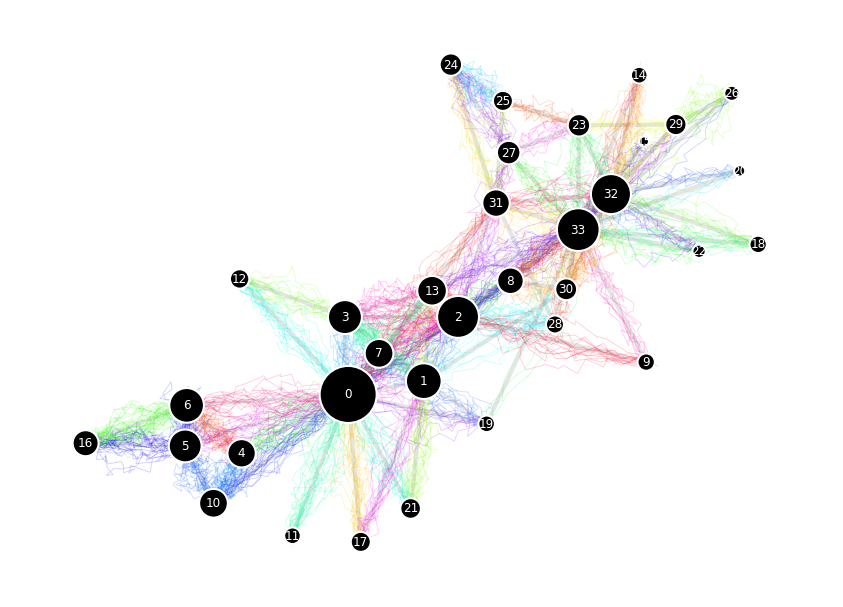
Random walk cover time on networks#
The cover time is the expected number of steps to reach every node, starting from a given initial distribution.
import random
def random_walk_coverage_time(G, start_node=None):
"""
Simulates a random walk on a network to determine the time taken to cover all nodes.
Starting from a specified or random node, the walker moves to a randomly chosen
neighboring node at each step. The walk continues until all nodes in the graph
have been visited at least once.
Parameters
----------
G : networkx.Graph
The graph representing the network on which the random walk is performed.
start_node : node, optional
The node where the random walk starts. If None, a random node is chosen.
Returns
-------
coverage_time : int
The number of steps required to visit every node in the graph at least once.
path : list
A list of nodes representing the path taken by the walker.
Notes
-----
- This function assumes the graph `G` is undirected and connected.
- If the graph has isolated components, some nodes may remain unvisited.
Examples
--------
>>> G = nx.path_graph(5)
>>> random_walk_coverage_time(G)
(7, [2, 1, 0, 1, 2, 3, 4])
"""
# Initialize the starting node
source = start_node if start_node is not None else random.choice(list(G.nodes))
nodes_covered = set([source]) # Track visited nodes
path = [source] # Track the path of the walker
N = G.number_of_nodes() # Total number of nodes in the graph
t = 0 # Step counter
if not nx.is_connected(G):
return 'help',[]
# print('Help')
# Continue walking until all nodes have been visited
while len(nodes_covered) < N:
# Get the neighbors of the current node
neighbors = list(G.neighbors(source))
# Choose a random neighbor and move there
target = random.choice(neighbors)
path.append(target)
nodes_covered.add(target) # Add the new node to the visited set
source = target # Update the current node
t += 1 # Increment the step count
return t, path # Return the time to cover all nodes and the path taken
How does cover time vary by network + size + structure?#
Simulate 10 BA networks of size [10, 50, 100, 500, 1000] with m = 6, and measure their average cover times.
Simulate 10 ER networks of same size and density, and measure their average cover times.
# Ns = np.logspace(1, 3, 20)
Ns = [10, 50, 100, 500, 1000]
m = 6
n_iter = 100
cover_ba = []
cover_er = []
for N in Ns:
N = int(N)
print(N)
cover_ba_n = []
cover_er_n = []
for _ in range(n_iter):
G_ba = nx.barabasi_albert_graph(N, m)
cover_t_ba, _ = random_walk_coverage_time(G_ba)
cover_ba_n.append(cover_t_ba)
G_er = nx.erdos_renyi_graph(N, nx.density(G_ba))
cover_t_er, _ = random_walk_coverage_time(G_er)
if not cover_t_er == 'help':
cover_er_n.append(cover_t_er)
cover_ba.append(np.mean(cover_ba_n))
cover_er.append(np.mean(cover_er_n))
10
50
100
500
1000
plt.loglog(Ns, cover_er, 'o-')
plt.loglog(Ns, cover_ba, 'o-')
plt.loglog(Ns, [N*np.log(N) for N in Ns])
[<matplotlib.lines.Line2D at 0x7f44f47d8310>]
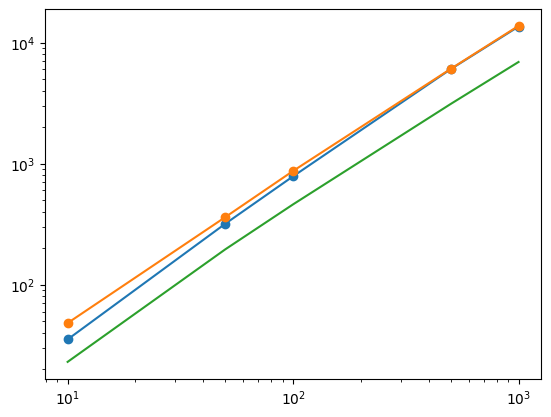
If there’s time: Work in pairs to code the mean first passage time in a network#
Mean First-Passage Time (MFPT):#
May also be called “Access or Hitting Time” to computer scientists.
The mean first passage time from node \(i\) to node \(j\) is the expected number of time–steps for reaching the node \(j\) for the first time, given that initially the walker starts from node \(i\).
Let us define the probability of reaching a node \(j\) after \(n\) steps starting from any other node: $\(p(j, n) = p_j (1-p_j)^{n-1}\)$
Approximately, $\(T_j = \sum_n^{\infty}\Delta t \times n \times p(j,n) \propto \frac{1}{p_j} = \frac{\sum_i k_i}{k_j}\)$
More mathematically,
\(T_{ij}\) : expected number of steps before node \(j\) is visited, starting from node \(i\).
\(T_{ii} = \frac{1}{p_i}\)
\(T_{ij} = \frac{F^{\#}_{jj} - F^{\#}_{ij}}{p_j}\)
\(\mathbf{F}^{\#}\) is the generalized inverse matrix of \(\mathbf{F} = \mathbf{I} - \mathbf{M} = \mathbf{I} - \mathbf{AD}^{-1}\)
for proofs, see
[1] Meyer, 1975, “The role of the group inverse in the theory of finite Markov chains”
[2] Cho & Meyer, 2000, “Comparison of perturbation bounds for the stationary distribution of a Markov chain”
Notes
In contrast to the stationary distribution vector, the mean first passage times give us information about the short range behavior of the chain.
Think about a practical weather forecasts:
we are going to have vacation somewhere, but find it is raining now there
what are we interested in?
what is the average number of rainy days vs sunny days throughout the year
OR
how long we can expect it to turn sunny, given that it is now raining ?
Next time…#
Dynamics 2 — Compartmental Models and Spreading Processes class_17_dynamics2.ipynb
References and further resources:#
Class Webpages
Jupyter Book: https://asmithh.github.io/network-science-data-book/intro.html
Syllabus and course details: https://brennanklein.com/phys7332-fall24
Masuda, Porter, & Lambiotte (2017). Random walks and diffusion on networks. Physics Reports, 716, 1-58. https://doi.org/10.1016/j.physrep.2017.07.007